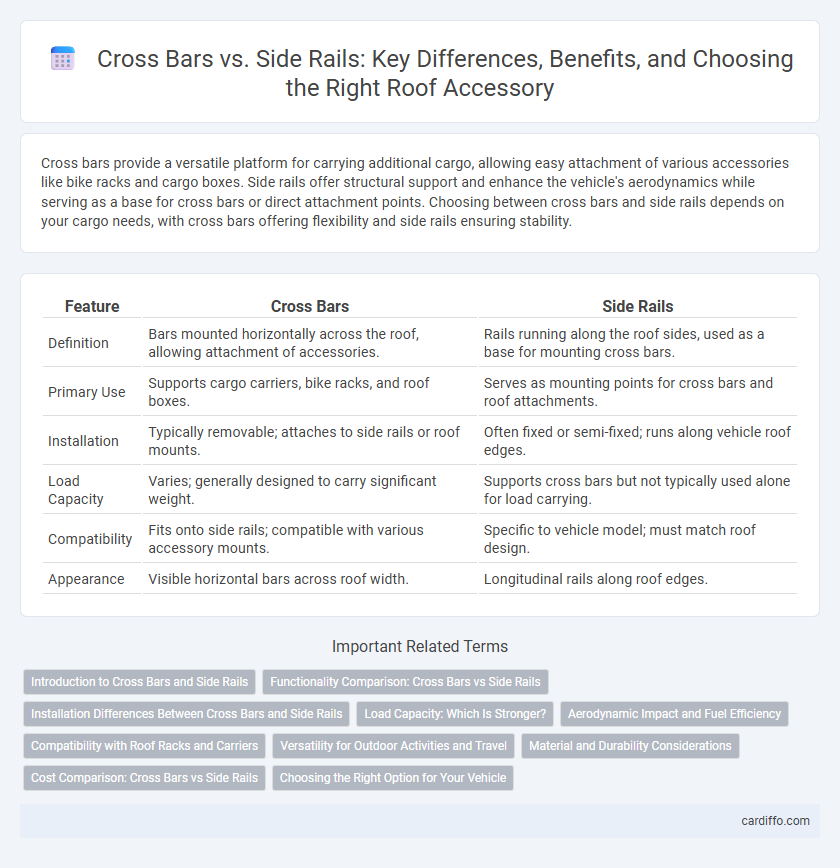Cross bars provide a versatile platform for carrying additional cargo, allowing easy attachment of various accessories like bike racks and cargo boxes. Side rails offer structural support and enhance the vehicle's aerodynamics while serving as a base for cross bars or direct attachment points. Choosing between cross bars and side rails depends on your cargo needs, with cross bars offering flexibility and side rails ensuring stability.
Table of Comparison
| Feature | Cross Bars | Side Rails |
|---|---|---|
| Definition | Bars mounted horizontally across the roof, allowing attachment of accessories. | Rails running along the roof sides, used as a base for mounting cross bars. |
| Primary Use | Supports cargo carriers, bike racks, and roof boxes. | Serves as mounting points for cross bars and roof attachments. |
| Installation | Typically removable; attaches to side rails or roof mounts. | Often fixed or semi-fixed; runs along vehicle roof edges. |
| Load Capacity | Varies; generally designed to carry significant weight. | Supports cross bars but not typically used alone for load carrying. |
| Compatibility | Fits onto side rails; compatible with various accessory mounts. | Specific to vehicle model; must match roof design. |
| Appearance | Visible horizontal bars across roof width. | Longitudinal rails along roof edges. |
Introduction to Cross Bars and Side Rails
Cross bars and side rails serve as essential components for vehicle roof storage systems, each offering distinct functionality and load capacity. Cross bars are horizontal bars mounted across the roof, providing a versatile base for attaching carriers, cargo boxes, and sports equipment. Side rails run along the length of the roof, acting as mounting points for cross bars and enhancing vehicle compatibility with various accessory configurations.
Functionality Comparison: Cross Bars vs Side Rails
Cross bars provide a sturdy horizontal platform for securing large items like bikes, kayaks, or cargo boxes, enabling versatile load management on vehicles. Side rails run along the edges of the roof, offering foundational support and compatibility with various cross bars and accessories, enhancing overall load distribution. Choosing between cross bars and side rails depends on specific transport needs, with cross bars excelling in direct load support and side rails facilitating flexible accessory attachment.
Installation Differences Between Cross Bars and Side Rails
Cross bars install by mounting directly across the vehicle roof, usually attaching to fixed points or roof rails, offering straightforward placement for carrying loads. Side rails run parallel to the length of the vehicle and require securing to designated mounting points along the roof edges, often demanding more precise alignment during installation. Cross bars typically provide quicker setup, while side rails involve additional steps for proper fastening and compatibility with various accessories.
Load Capacity: Which Is Stronger?
Cross bars generally offer higher load capacity than side rails due to their direct support across the roof, distributing weight evenly and enhancing stability for heavy cargo. Side rails primarily serve as a mounting base for cross bars and do not provide substantial load-bearing strength on their own. For maximizing load capacity, combining sturdy cross bars with well-installed side rails ensures better durability and safety for carrying heavy items.
Aerodynamic Impact and Fuel Efficiency
Cross bars create a higher profile on vehicles compared to side rails, resulting in increased air resistance and reduced aerodynamic efficiency. Side rails, closely aligning with the vehicle's contours, minimize drag and contribute to better fuel economy by maintaining smoother airflow. Choosing side rails over cross bars can lead to noticeable improvements in fuel efficiency due to their lower impact on the vehicle's aerodynamics.
Compatibility with Roof Racks and Carriers
Cross bars offer broad compatibility with various roof racks and carriers due to their standardized mounting systems and adjustability, making them ideal for securing bikes, cargo boxes, and skis. Side rails provide a stable base that integrates seamlessly with specific roof rack systems designed for particular vehicle models, enhancing aerodynamic efficiency and load distribution. Compatibility depends largely on the vehicle's design and the accessory type, with cross bars offering more universal adaptability compared to the custom-fit nature of side rails.
Versatility for Outdoor Activities and Travel
Cross bars offer superior versatility for outdoor activities and travel by providing a stable, adjustable platform for securing various gear such as bikes, kayaks, and cargo boxes. Side rails, while primarily designed to enhance roof protection and aesthetic appeal, limit direct attachment options without additional accessories. Cross bars facilitate efficient load distribution and compatibility with diverse mounts, making them essential for adaptable and reliable transport solutions.
Material and Durability Considerations
Cross bars are typically made from high-strength aluminum or steel, offering superior durability and corrosion resistance for heavy-duty use. Side rails are often constructed from aluminum or reinforced plastic, balancing weight reduction with adequate sturdiness for everyday cargo. Choosing between cross bars and side rails depends on the material's ability to withstand environmental conditions and the expected load capacity.
Cost Comparison: Cross Bars vs Side Rails
Cross bars generally cost less than side rails, with prices starting around $50 compared to $100 or more for side rails, making them a more budget-friendly option for carrying cargo. Side rails offer increased versatility and support for heavier loads, which may justify their higher price for users needing durable, multi-purpose solutions. When selecting between cross bars and side rails, evaluating the specific load capacity and frequency of use helps determine the best cost-effective accessory for vehicle roof storage.
Choosing the Right Option for Your Vehicle
Cross bars provide a sturdy, universal mounting solution ideal for carrying large or bulky items like bikes and kayaks, while side rails offer a streamlined, factory-integrated look that complements your vehicle's design. Prioritize compatibility with your vehicle's roof type and intended cargo to determine whether adjustable cross bars or fixed side rails better meet your needs. Consider factors such as load capacity, ease of installation, and aerodynamic efficiency to select the most suitable accessory for enhanced utility and safety.
Cross bars vs Side rails Infographic

 cardiffo.com
cardiffo.com